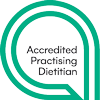9 common myths about Intuitive Eating
Even though it’s been over 25 years since Intuitive Eating was created by dietitians Evelyn Tribole and Elyse Resch (Intuitive Eating’s original creators), myths about Intuitive Eating still abound. This is partly because there’s a lot of confusion about the actual definition of Intuitive Eating, and partly because it’s goal is to help people eat, live and move in a way that doesn’t focus on weight, and is therefore at odds with more mainstream messages about weight and health. Along with the rising interest in Intuitive Eating, parts of it are now also being exploited in ways for which it was not intended. In this blog, I unpack 9 myths about what Intuitive Eating is and isn’t.
Myth 1: Intuitive Eating is anti-health
Intuitive Eating is often portrayed as being anti-health, but it’s actually pro health. Unlike mainstream approaches to health, where the focus is typically only on achieving and maintaining a certain weight (and at any cost), the Intuitive Eating framework recognises that health is not just physical, but also mental, emotional, and social. It accepts and honours our body’s mental and emotional needs, in addition to the physical ones. Contrary to what you may have heard, the science is clear: BMI is a very poor proxy for health (Content Warning: O words used). Intuitive Eating aligns with the non-diet approach to health which focusses on actual measures of health, like lab values along with behaviours that are known to be health-promoting like eating a variety of foods, improving diet quality, getting enough quality sleep, moving in ways that feel good and are fun, as well as managing chronic stress and emotions in helpful ways. It considers what your relationship with food and your body looks like, since these have considerable influence on how we eat, sleep, move and generally show up in the world. In short, Intuitive Eating removes the focus on one arbitrary number (your weight or BMI) and frees you to focus more on the many different aspects of health. Moving away from rigid diet rules helps you create a positive relationship with food that allows you to adopt sustainable, health-promoting habits rooted in self-care. And all of this is supported by a growing body of research that shows positive health outcomes with Intuitive Eating.
Myth 2: Intuitive Eating is all instinctual
Another common myth is that Intuitive Eating is all instinctual and you can simply take it up overnight. Although one dictionary definition of “intuitive” is “instinctive,” Intuitive Eating is a way of eating that requires a combination of instinct, emotion, and thought. To understand this better, we can think of it as using different yet essential parts of our brain: the part of our brain that controls primal instincts and impulses, the part which is responsible for feelings, and the part which generates thoughts. Using these different parts of our brain when it comes to eating is important. For example, relying on instinct alone isn’t helpful, if you don’t have much of an appetite because you’re anxious, super stressed, grieving or unwell, because you probably wouldn’t eat or eat enough. In this situation, it’s important that the “rational” part of the brain (the part that generates thoughts) can remind you that you should probably eat anyway.
Intuitive Eating is about learning to listen to the physical and emotional signals that our body is sending us and using this information to help us honour our needs (physical, mental, emotional and social) and make decisions about food and eating along with movement, that are helpful for both us and our body. This is neither instinctual, nor straightforward and very often requires additional support from a certified Intuitive Eating professional.
Myth 3: Intuitive Eating means eating whatever, whenever
Part of making peace with food is having unconditional permission to eat a concept that people frequently misunderstand. It’s true that in the early days of Intuitive Eating, after you’ve been deprived of certain foods (even if they’ve just been mentally off-limits), you may want to eat and go to town on these foods (known as the honeymoon phase in Intuitive Eating). This is a natural reaction to deprivation – which is what leads to feeling out-of-control around these foods or just food in general. However, this phase doesn’t last forever. When you eat a food you find irresistible regularly, something called habituation occurs and that previously irresistible food loses its special appeal. Explained another way: once that food is no longer taboo and you truly don’t feel deprived of it anymore, it isn’t any more alluring than other foods, it becomes just another food.
At the same time, Intuitive Eating also pairs unconditional permission to eat with attunement to the physical sensations that arise from within the body, which include hunger and fullness, as well as the physical sensations that accompany emotions. Attunement refers to listening to the signals your body gives you, which means you’re not only asking yourself, “what would taste good?”, you’re also asking yourself other questions like, “How hungry/full am I?”, “Will this meal satisfy me?”, “How will eating this food make me feel?” “Is this how I want to feel?”
When habituation happens alongside unconditional permission to eat and attunement, you eventually get to a place where you eat a wide variety of foods, including some that were previously off-limits for you and others that you were actively encouraged to eat on the diets you followed. You will still sometimes crave the foods that were previously off-limits, but you will also start to want – and genuinely enjoy – lots of other foods, including fruit and vegetables. Intuitive Eating is in fact associated with a higher intake of fruit and vegetables.
Again, it often takes additional support from a certified Intuitive Eating professional to get through the honeymoon phase, but ultimately it is possible to get to a place where you can choose foods that taste good to you and help you feel good.
Myth 4: Intuitive Eating will help you lose weight
Intuitive eating is about creating a respectful and nurturing relationship with food and your body. Unfortunately, along with the rising interest in Intuitive Eating, parts of it are now being exploited in ways for which it was not intended. For example, it is sometimes offered with the promise of weight loss. However, Intuitive Eating is not a weight-loss plan. If anyone promises you that it will lead to weight loss, they are either terribly mistaken or exploiting it for financial gain. This is why, if you want to pursue Intuitive Eating, I strongly recommend working with someone who has been certified by Intuitive Eating’s original creators.
While it’s true that some people may lose weight unintentionally when they start practicing Intuitive Eating, others will gain weight they lost through dieting or restriction and some will stay more or less the same weight. In my experience, most people who have been restricting what they eat in some way before beginning their Intuitive Eating journey, do gain some weight (no matter what size they started out at). This is often one of the most challenging parts of finding peace with food and your body.
Myth 5: Intuitive Eating is anti-dieters and anti-weight loss
Non-diet approaches to health like Intuitive Eating are anti- diet culture, not anti-people who diet. They aim to disrupt the diet culture narrative that makes people feel like they have to diet, while at the same time acknowledging the fact that many people, understandably, feel the need and pressure to diet in culture we live in.
While weight change is not the focus or goal of Intuitive Eating, it is not anti-weight loss. Any unintentional weight loss – which some people experience when they adopt Intuitive Eating – is considered neutral. However, intentionally and actively trying to lose weight is not compatible with Intuitive Eating because dieting means focussing on external rules about food and movement and this prevents you from fully tuning into your body’s physical and emotional cues, a key concept in Intuitive Eating.
Myth 6: Intuitive Eating is eating only when you are hungry and stopping the moment you feel full
Intuitive Eating often gets reduced to the “hunger-fullness” diet because two of the Intuitive Eating principles are about honouring your hunger and learning to feel your fullness cues. But these are just two of the 10 principles of Intuitive Eating, and they are designed to be practised in the context of all the other ones—including rejecting the diet mentality. Trying to eat only when you are experiencing a certain level of hunger and stopping at a certain level of fullness is dieting – the very behaviour and mindset Intuitive Eating seeks to help people break away from.
Also, trying to eat only when you’re hungry and stop when you’re full isn’t very helpful because it doesn’t acknowledge all the other reasons we eat, which can be emotional, practical etc. One example of emotional eating might be eating a chicken soup when we have a cold because it’s comforting. We also need to eat “practically” on occasions, even though we might not feel especially hungry. For example, we might need to eat before going into back-to-back meetings where we know we won’t have access to food for some time, even though we aren’t hungry. Both these are examples of eating as a matter of self-care.
Myth 7: Intuitive Eating is not science-based
Intuitive Eating is a science-based mind-body approach to eating and movement that was developed by two registered dietitians, Evelyn Tribole and Elyse Resch. At the time of writing, over 200 studies support its’ use. The Intuitive Eating assessment tool has also been scientifically validated.
Myth 8: You can’t use Intuitive eating in eating disorder recovery
The myth that Intuitive Eating can’t be used in eating-disorder recovery is based on the misconception that Intuitive Eating is only (or mostly) about hunger and fullness. Yes, it’s true that hunger and fullness cues are typically unreliable for someone who has an active eating disorder, because disordered eating leads to physiological changes and disturbances in the digestive tract like delayed stomach emptying, constipation, nausea, and bloating that can make people feel full too quickly and not feel hungry until they’re absolutely ravenous (if at all). This means, if you have an active eating disorder, trying to eat based on hunger and fullness cues can result in restrictive eating that impedes recovery.
That said, honouring your hunger and learning to feel your fullness are just two of the 10 principles of Intuitive Eating. Many of the other principles are crucial to healing from eating disorders. In particular, rejecting the diet mentality, making peace with food , challenging your inner food critic, reclaiming pleasure and satisfaction in food, and respecting your body are important for helping people heal from eating disorders and subclinical disordered eating behaviours. Also, with recovery, hunger and fullness cues eventually return and become reliable and the principles honouring your hunger and learning to feel your fullness can eventually be practised.
Myth 9: If you have a health condition, you can’t practise Intuitive Eating
If you’ve been diagnosed with a health condition like diabetes, coronary heart disease, high blood pressure or high blood cholesterol, then you’ve probably been provided with some diet and lifestyle advice at some point. Since this advice often places an emphasis on reducing food intake with the ultimate goal of weight loss, it can be difficult to imagine how Intuitive Eating can still help you manage your health condition, especially when the version of Intuitive Eating often depicted on social media suggests it’s only about eating whatever, whenever. This (along with the fact that Intuitive Eating is frequently referred to as an anti-diet approach), is why people often think it can’t be used for a health condition they might have.
Not only can Intuitive Eating be used in the presence of a health condition, it can actually enrich it. For example, if someone has diabetes, an Intuitive Eating approach might look like helping that person explore their overall relationship with food – in particular their relationship with carbohydrate-rich foods. It’s not uncommon for someone with diabetes to find themselves in a restrict-binge cycle with these foods, something that is often the result of needing to manage these foods for their condition and them being demonised in by diet culture. A dietitian certified in Intuitive Eating would also help them honour their hunger so that they’re no longer eating in a way that sets themselves up to binge, help them make peace with carbs and understand that they have unconditional permission to eat. They would also help them explore how different foods and meals affect their blood sugar levels, so they can find out what foods work best for their body.
As well as being a more sustainable approach, and one that promotes more autonomy, a 2021 meta-analysis found Intuitive Eating is also associated with reduced disordered eating. Since disordered eating is more common in people with health conditions requiring nutritional therapy like diabetes, coeliac disease, gastrointestinal disorders and others, Intuitive Eating may help mitigate the risk of disordered eating in these conditions.
Final words
Your body is really smart. Intuitive Eating is a framework that helps you respect and tap into that wisdom. While diets and food rules work to disconnect you from this wisdom, the principles of Intuitive Eating foster connection with it, improving your relationship with food and your body. If you wish to, you can find out more about the 10 principles of intuitive eating here.
Ready to take the next step? Contact me and request a complimentary call to find out more about Intuitive Eating and how it can help you truly nourish yourself – body, mind and soul.






